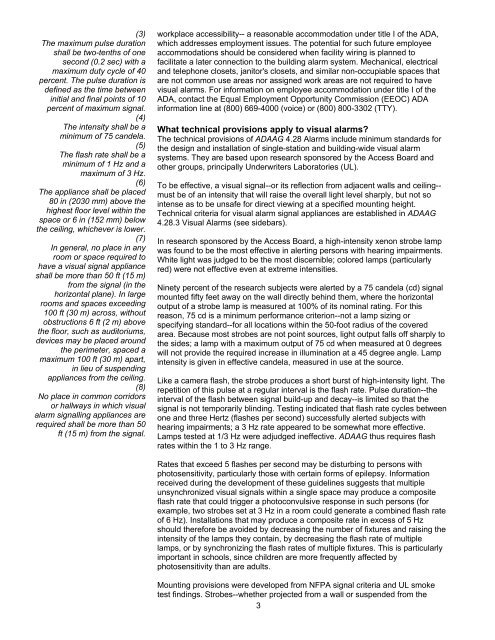Fire Protection Design Manual - Office of Construction and Facilities ...
Fire Protection Design Manual - Office of Construction and Facilities ...
Fire Protection Design Manual - Office of Construction and Facilities ...
You also want an ePaper? Increase the reach of your titles
YUMPU automatically turns print PDFs into web optimized ePapers that Google loves.
(3)<br />
The maximum pulse duration<br />
shall be two-tenths <strong>of</strong> one<br />
second (0.2 sec) with a<br />
maximum duty cycle <strong>of</strong> 40<br />
percent. The pulse duration is<br />
defined as the time between<br />
initial <strong>and</strong> final points <strong>of</strong> 10<br />
percent <strong>of</strong> maximum signal.<br />
(4)<br />
The intensity shall be a<br />
minimum <strong>of</strong> 75 c<strong>and</strong>ela.<br />
(5)<br />
The flash rate shall be a<br />
minimum <strong>of</strong> 1 Hz <strong>and</strong> a<br />
maximum <strong>of</strong> 3 Hz.<br />
(6)<br />
The appliance shall be placed<br />
80 in (2030 mm) above the<br />
highest floor level within the<br />
space or 6 in (152 mm) below<br />
the ceiling, whichever is lower.<br />
(7)<br />
In general, no place in any<br />
room or space required to<br />
have a visual signal appliance<br />
shall be more than 50 ft (15 m)<br />
from the signal (in the<br />
horizontal plane). In large<br />
rooms <strong>and</strong> spaces exceeding<br />
100 ft (30 m) across, without<br />
obstructions 6 ft (2 m) above<br />
the floor, such as auditoriums,<br />
devices may be placed around<br />
the perimeter, spaced a<br />
maximum 100 ft (30 m) apart,<br />
in lieu <strong>of</strong> suspending<br />
appliances from the ceiling.<br />
(8)<br />
No place in common corridors<br />
or hallways in which visual<br />
alarm signalling appliances are<br />
required shall be more than 50<br />
ft (15 m) from the signal.<br />
workplace accessibility-- a reasonable accommodation under title I <strong>of</strong> the ADA,<br />
which addresses employment issues. The potential for such future employee<br />
accommodations should be considered when facility wiring is planned to<br />
facilitate a later connection to the building alarm system. Mechanical, electrical<br />
<strong>and</strong> telephone closets, janitor's closets, <strong>and</strong> similar non-occupiable spaces that<br />
are not common use areas nor assigned work areas are not required to have<br />
visual alarms. For information on employee accommodation under title I <strong>of</strong> the<br />
ADA, contact the Equal Employment Opportunity Commission (EEOC) ADA<br />
information line at (800) 669-4000 (voice) or (800) 800-3302 (TTY).<br />
What technical provisions apply to visual alarms?<br />
The technical provisions <strong>of</strong> ADAAG 4.28 Alarms include minimum st<strong>and</strong>ards for<br />
the design <strong>and</strong> installation <strong>of</strong> single-station <strong>and</strong> building-wide visual alarm<br />
systems. They are based upon research sponsored by the Access Board <strong>and</strong><br />
other groups, principally Underwriters Laboratories (UL).<br />
To be effective, a visual signal--or its reflection from adjacent walls <strong>and</strong> ceiling-must<br />
be <strong>of</strong> an intensity that will raise the overall light level sharply, but not so<br />
intense as to be unsafe for direct viewing at a specified mounting height.<br />
Technical criteria for visual alarm signal appliances are established in ADAAG<br />
4.28.3 Visual Alarms (see sidebars).<br />
In research sponsored by the Access Board, a high-intensity xenon strobe lamp<br />
was found to be the most effective in alerting persons with hearing impairments.<br />
White light was judged to be the most discernible; colored lamps (particularly<br />
red) were not effective even at extreme intensities.<br />
Ninety percent <strong>of</strong> the research subjects were alerted by a 75 c<strong>and</strong>ela (cd) signal<br />
mounted fifty feet away on the wall directly behind them, where the horizontal<br />
output <strong>of</strong> a strobe lamp is measured at 100% <strong>of</strong> its nominal rating. For this<br />
reason, 75 cd is a minimum performance criterion--not a lamp sizing or<br />
specifying st<strong>and</strong>ard--for all locations within the 50-foot radius <strong>of</strong> the covered<br />
area. Because most strobes are not point sources, light output falls <strong>of</strong>f sharply to<br />
the sides; a lamp with a maximum output <strong>of</strong> 75 cd when measured at 0 degrees<br />
will not provide the required increase in illumination at a 45 degree angle. Lamp<br />
intensity is given in effective c<strong>and</strong>ela, measured in use at the source.<br />
Like a camera flash, the strobe produces a short burst <strong>of</strong> high-intensity light. The<br />
repetition <strong>of</strong> this pulse at a regular interval is the flash rate. Pulse duration--the<br />
interval <strong>of</strong> the flash between signal build-up <strong>and</strong> decay--is limited so that the<br />
signal is not temporarily blinding. Testing indicated that flash rate cycles between<br />
one <strong>and</strong> three Hertz (flashes per second) successfully alerted subjects with<br />
hearing impairments; a 3 Hz rate appeared to be somewhat more effective.<br />
Lamps tested at 1/3 Hz were adjudged ineffective. ADAAG thus requires flash<br />
rates within the 1 to 3 Hz range.<br />
Rates that exceed 5 flashes per second may be disturbing to persons with<br />
photosensitivity, particularly those with certain forms <strong>of</strong> epilepsy. Information<br />
received during the development <strong>of</strong> these guidelines suggests that multiple<br />
unsynchronized visual signals within a single space may produce a composite<br />
flash rate that could trigger a photoconvulsive response in such persons (for<br />
example, two strobes set at 3 Hz in a room could generate a combined flash rate<br />
<strong>of</strong> 6 Hz). Installations that may produce a composite rate in excess <strong>of</strong> 5 Hz<br />
should therefore be avoided by decreasing the number <strong>of</strong> fixtures <strong>and</strong> raising the<br />
intensity <strong>of</strong> the lamps they contain, by decreasing the flash rate <strong>of</strong> multiple<br />
lamps, or by synchronizing the flash rates <strong>of</strong> multiple fixtures. This is particularly<br />
important in schools, since children are more frequently affected by<br />
photosensitivity than are adults.<br />
Mounting provisions were developed from NFPA signal criteria <strong>and</strong> UL smoke<br />
test findings. Strobes--whether projected from a wall or suspended from the<br />
3

















